Literature has always changed. Pick up any book by Virginia Woolf and you’ll actually have a hard time reading it because of the style it’s written in. But for its time, it was considered normal (in additional to excellent). It’s important to understand this as we look at the self publishing trends for 2024, and every year for that matter.
Making a full time living with your books can happen by chance—by you just writing what you want to write. However, you can also increase your chances of selling books by understanding the consumers in your market. What they like, dislike, and where the industry as a whole is headed.
That’s what we’ll look at in this post. We’ll go over the self publishing trends for 2024 for both fiction and nonfiction categories, along with some microtrends you’ll want to keep an eye on.
Here’s what we’ll uncover for self publishing trends for 2024:
Nonfiction Self Publishing Trends for 2024
Nonfiction is such a broad genre that it’s tough to fit all of the trends into one. So what we’ll do here is take a look at overarching trends within the book world specific to nonfiction authors.
1. Highly Niched Topics
“Self help” used to be a category that didn’t have too many types of books. They were about improving your life, and they were fairly broad, with tips and tricks that would work for many types of people. They were generalized, if you will.
Now, if you say “a self help book” the person you’re talking to might ask, “What kind?” because the genre has grown immensely over the last 20 years, but especially over the last 5. Now, there are 28 individual subgenres on the self help book page, ranging from issues of abuse to that of time management and general success.
With the expansion of the internet, and many people shifting to running their own business—often by themselves—from their social media platforms, what we see now more than ever are the stories of “how did you do that?”
It goes like this:
Person A (the will-be author) starts creating content online in which they share about their lives.
Person B saw their content and started following them, because they could relate to it.
Person A started to notice an influx of followers around a certain topic—let’s say, about being silly and not taking yourself too seriously.
Person B, C, D, and the rest of the alphabet then sent many messages over time to Person A asking a version of the same question, “How did you learn to live like that? It looks so freeing, but I could never.”
Person A starts to see a trend, and perhaps was even encouraged to share their methods by writing a book.
Instead of writing a book about their life as a whole, Person A observed that their following wanted specific help in a specific area; how to not take themselves and life too seriously.
That is how a highly niche book comes to be, and this is happening across hundreds of niches on the internet, from homesteading (and raising chickens) to flipping houses to the obscure world of breeding clownfish. This is largely in part because the general population is also understanding how to use the internet, and therefore books, to learn exactly what they want without the fluff of generalized topics.
It’s the deep-dive the current consumer is looking for. They want a book they can highly relate to the majority of the book, and not a book in which they might relate to a certain section only. For that reason, this makes the list of the top self publishing trends for 2024 for self-published authors to be aware of.
We’ve been teaching the idea of “niching down” and understanding your ideal avatar for years in our programs, and the rest of the world is catching up to this. The more specific the book, the more likely you’ll sell copies to a specific audience, giving them exactly what they need and serving them a positive experience (that will turn into 5-star reviews).
We’ll continue to see categories niche down more and more even on Amazon, so if you think your idea is too specific, think again. It’s probably perfect, and possibly not specific enough, but our coaches can help you determine that for sure.
2. Stair-Step Multiple Book Catalogs
This is based on the above, but takes a stronger look at what we call the “customer journey”. In this case, it’s the reader’s journey. However, this is one of the self publishing trends for 2024 that has more to do with the author and their overall book strategy.
Fiction authors have something similar but also very different that’s covered in that section.
For nonfiction authors, this is about creating a business plan for your nonfiction book catalog, one that not only brings in new readers consistently, but continues to serve current readers with more books.
Authors are writing multiple books around the same overarching topic but with variations of specificity and advancement of the topic, and it’s now become one of the self publishing trends for 2024 to plan for this.
Think about it this way: someone is just beginning their experience of keeping honeybees on their property. When they first start, they need a very general overview of what the process is and what it looks like. They need to know the equipment and general tips. But what happens when they get the bees and have learned and done everything that book covered but are still met with challenges or a lack of knowledge?
They need more information in specific areas. Now, they’re challenged with issues about bees not returning to the hive. Or maybe what to do with excess honey and the combs. What about if they want to begin a honey-goods selling business?
As you can see, this single reader can consume not just one of the author’s books, but 4. Because at each stage of development of this journey, they have needed help, and why not go back to the author who helped them get it set up?
This is how authors develop their ecosystem.
But here’s the real benefit and why this trend is spreading so rapidly:
1 reader buys 1 book for $12.99 = $12.99 in revenue for the author
1 reader buys 4 books each for $12.99 = $51.96 in revenue for the author
Now compound that by several hundred readers:
300 readers buy 1 book each for $12.99 = $3,897
300 readers buy 4 books each for $12.99 = $15,588
As you can see, this very quickly changes from small change to substantial income as you increase the amount of books you have. However, note that this isn’t necessarily going to be the case if you write multiple books of unrelated topics.
Someone who wants to learn about beekeeping might not care about all-natural skincare (despite honey being used in those recipes). That’s why this, among the other self publishing trends for 2024, requires planning, book mapping, and creating a long-term strategy with your books.
Scott Allan, self-published author and book coach, demonstrates this really well with multiple collections aimed at solving an over-arching challenge by zooming in on specifics.

Lisa Zelenak is another author who offers a stair-step approach and follows this as one of the self publishing trends for 2024. In her case, she first helps you Find Your Thing and then she helps you Start Your Thing. She recognized that her audience can’t begin until they discover, and offered those as two separate books.
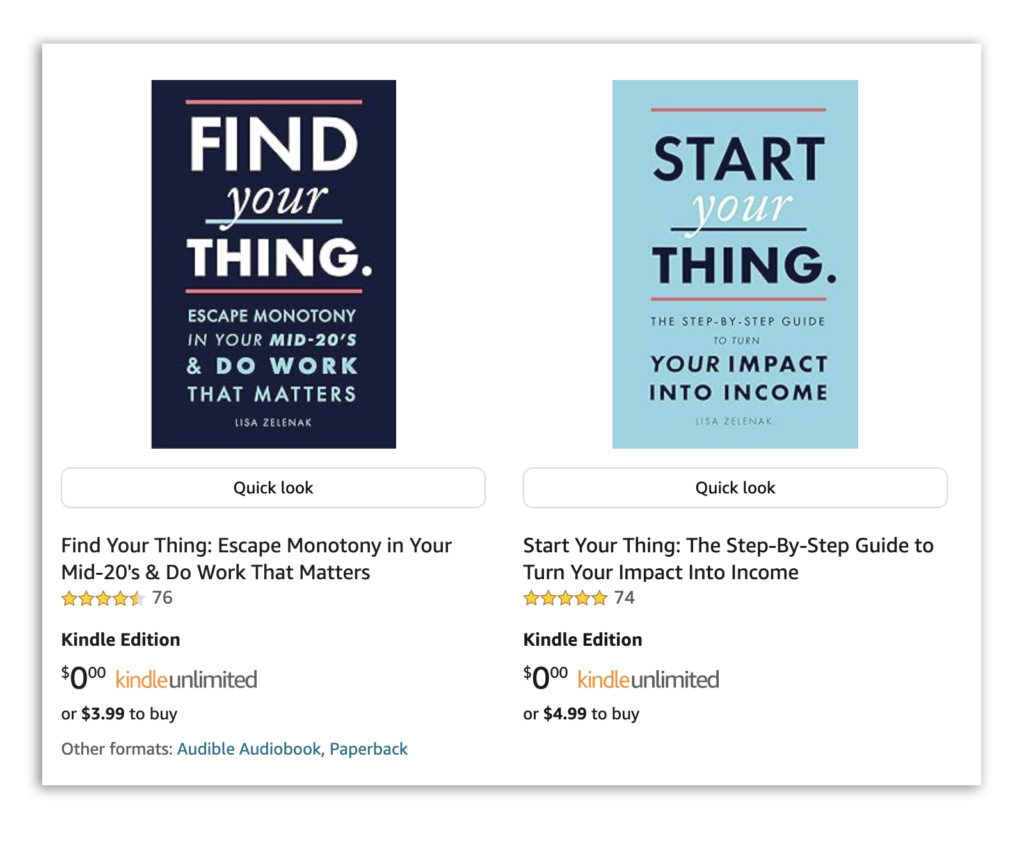
To follow along with the self publishing trends for 2024 in this case, make sure to take a strong look at not just the main topic of what you know, but how much you know about that topic and the various stages.
3. Business model shared in a book
Many nonfiction authors who are also business owners nowadays are utilizing this one most among the self publishing trends for 2024. The trend is actually pretty simple, too:
Share your business model, what you do and how you do it, in a book and sell it.
That’s all! I know, it sounds easy, and that’s because it really is. If you started and have a successful business in a certain field, people may want to know how you did it. They want to start it too, basically. Where once, entrepreneurs may have ignored comments like “tell us how you did it!” the accessibility of self publishing alone is making it easier and easier for those people to say “yeah, I’ll write a book about it.”
Now of course, that book still has to be good and set up in a way to sell, but you’ll find more entrepreneurs releasing books based on their business itself in order to help other people do what they’ve done—primarily in the creative fields, as that industry is proving to be much “easier” to break into due to social media and the potential to sell artwork online.
4. Podcast / Platform theme in a book
The platform-to-book pipeline is hot and this one among all the self publishing trends for 2024 is rapidly growing.
The idea is simple: you’ve grown a platform via social media, Youtube, or even a podcast, and have written a book that encompasses your theme or niche. Specifically here, there is a strong, strong correlation for those who have a podcast to write a book.
Almost all of these also include a platform on social media. It’s about taking your theme as a platform and turning it into a book. It’s just creating a new format of “what you are” in a package that’s more intimate, with much more information, and can be consumed in a different way.
These are all interconnected when selling, too. Someone has many entry-points to discover you and your message. They might see a social media post first. Then listen to the podcast. Then buy the book that you advertise on your podcast.
It also gives you a means to advertise yourself on other podcasts. It’s not often podcasts host guests who only have another podcast to promote. It’s not unheard of, but if you have a book, the likelihood of getting podcast interviews where you can promote it increases significantly.
Podcasts are a huge and often overlooked market for book sales for most authors. But a book can be a really strong method to expand your income stream if you already have a book. That’s why this is one of the self publishing trends for 2024. Notably, though, some podcasters get offered traditional publishing deals.
But let’s look at a few examples of how this has been done before so you can understand one the stand-out self publishing trends for 2024:
Pillow Talks – Sex Talks
Began as: a podcast platform, social media, then book
Podcast Theme: A sex therapist with 20 years of experience and her husband discuss intimate, long-term relationships and the nuances faced when it comes to physical intimacy and sex.
Book Theme: A how-to guide for approaching 5 crucial conversations you can have with your partner that will aid in your emotional and sexual health as a couple.
Breakdown: The podcast informed the book and the book has been informing the podcast since its release. The author and her husband both contributed to the book, though Vanessa Marin wrote the bulk of it as the sex therapist herself. Both are about essentially the same thing, but in different formats, with the book uncovering much more detailed nuances and patient stories.
Goal Digger – How Are You, Really?
Began as: social media platform, then podcast, then book
Podcast Theme: Goal Digger is a marketing and business podcast specifically aimed at helping women create and achieve their goals, while juggling the nuances women deal with in the entrepreneur world
Book Theme: How Are You, Really? Takes a broader approach to achieving one’s goals by getting real about how you’re doing and what you need to feel fulfilled in life, whatever that looks like for you. It coincides with the podcast by covering the same topics of balancing life and business
Financial Feminist – Financial Feminist
Began as: social media, then podcast, then book
Podcast Theme: Helping women take financial control through education of the financial world and applicable steps to begin financial literacy.
Book Theme: Basically the same as the podcast, but a broader and deeper look at the financial world, women’s challenges in this world, and what you can do to be financially independent and free.
If you want to start this one of all the self publishing trends for 2024, it does require additional content. A social media platform or a podcast. If you already have a platform, start by answering the question you’re most asked and seeing if that encompasses the theme of your platform.
5. Skillset technical books
College is on the outs. And look, I never went to college because I wholeheartedly believed I could figure out how to do what I wanted myself, and I have. I’m one of the many examples of people who have done this, and are often vocal to contemplative teenagers about it.
This is where the trend is starting, along with the increase in highly specified experts sharing their knowledge online—and for free, in most cases.
Now, obviously if you want to be a doctor or in a field that requires a much more advanced education, college is necessary. But it’s not for many people, especially for those who don’t know what they want to do, but they know it’s not one of those fields.
With this trend, there is a demand. And where there is a demand, the market opens for those to fulfill it. In this case, that looks like skillset technical books. Essentially, textbooks, but not in that format or with the baggage of extreme distaste many of us carry at that term for a book.
Here’s an example of an author who has taken advantage of the influx in homesteading and self-sufficiency (outlined more in the microtrends section below) though this author got started years ago, the recency of reviews suggests their books have become popular recently:
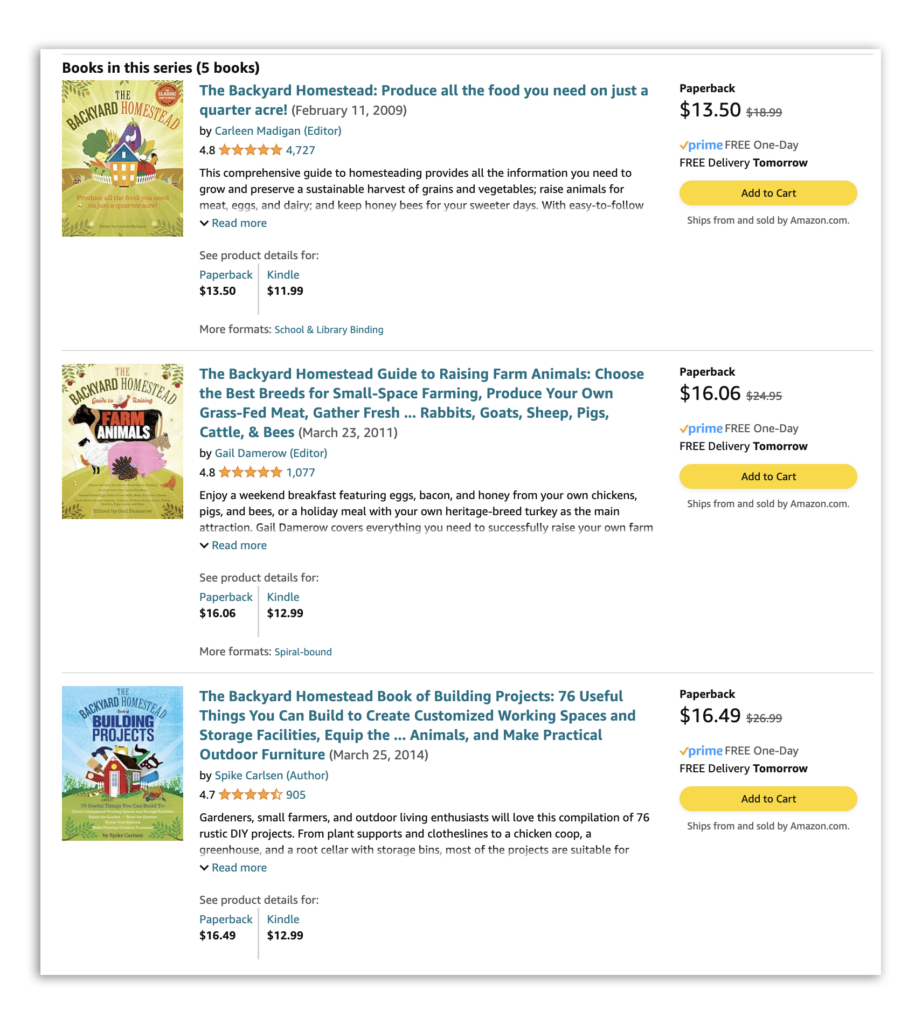
As you can see, she’s created a book for each part of the process. These can be used as a replacement for “traditional” education in order to teach people how to create an entire lifestyle that’s self-sufficient. You will see many more book collections of a similar nature as this becomes one of the bigger self publishing trends for 2024.

Fiction Self Publishing Trends for 2024
The fiction world looks much different than nonfiction, and the reason why is easy. There are so many books in so many genres and subgenres to consider. In this section specifically, we’ll focus on overarching, industry-wide self publishing trends for 2024.
1. Hyper Specification in Genre & Category
One thing that’s become clear in the self-publishing world as of late is the fact that being highly focused in the genre, subgenre, category, and even tropes used in your books can make all the difference for selling copies. We’ve been teaching our authors this for a while now, but it’s being taken to more extremes and is one of the self publishing trends for 2024 you’ll want to abide by.
Because it does affect the Amazon algorithm, and even an entity like Amazon will adjust its own methods when the consumers want more searchability for books.
Remember, Amazon is a business and wants to sell books. So if readers are asking for and utilizing their own versions of more specific searches, the software will follow suit. In the last couple of years alone, the navigation bar on Amazon has made updates to include more specificity in narrowing your search by including more subgenres, more categories, popular and trending tropes, and more.
Even in the romance genre itself, there has been an additional 12 subgenres shown on the sidebar to help readers narrow their search. In the image below, there’s a screenshot of Amazon’s “Romance” genre page, the top from May of 2021 and the right from February of 2024 with the new subgenres or categories highlighted.
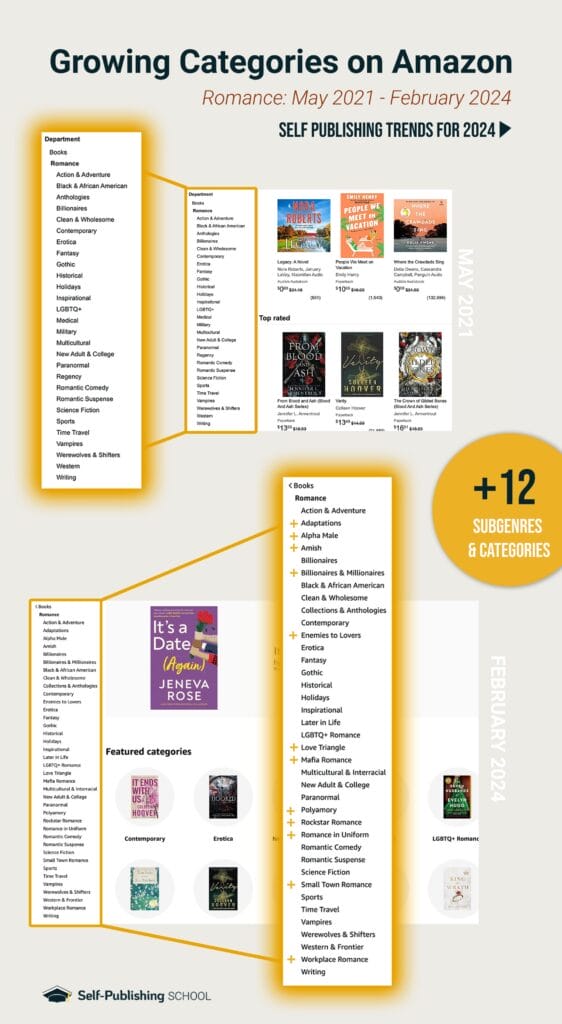
This is a direct result of consumers’ desires for more specificity. They want to find exactly what they’re looking for, and it’s your job as the self-published author to make sure your book is visible if it fits that criteria.
We’re even seeing this in the increase of the genre “romantasy”. Now, a few years ago, this term didn’t exist. But because of the influx and popularity of a few trending books that bridged the romance and fantasy genres, this term is now used fairly often. This gives us reason to believe not only will this trend continue, but that one of the biggest self publishing trends for 2024 will be hyper specifications of genre and category.
There’s no saying when Amazon will make an update to include this reader-created subgenre, but it’s bound to at least be a term used when you self-publish and choose your categories and keywords.
Now, this isn’t to say that the authors themselves are highly specified. This is about the author names and which books are published under which account. Meaning, pen names are becoming more and more popular in order to specify the entire makeup of an author’s profile.
How you can keep with this trend:
- Make sure your author profile has a consistent genre you publish in
- Update your book description to include some keywords like your trope
- Make sure you’re choosing the right categories (and requesting extra ones)
- Use this information to write to market to featured tropes and categories
2. Connected Standalones Instead of Series
What goes around comes around, right? When books were first starting to be consumed en masse, many did so by reading standalone novels. These are singular stories captured in one book, and they don’t have any other books that relate to the people, time period, or world.
These are making a comeback, with many authors choosing to add or include standalone stories in their world, or only write standalones, but connect them in other ways. While many genres have always had an equal amount of standalone stories to book series (like contemporary or thrillers/suspense), what’s really among the self publishing trends for 2024 are typically heavy book series genres now including more standalone stories.
Take the fantasy genre, for example.
Fantasy used to be singular novels, but has morphed over time to be a genre that has expected book series. It’s been unusual to see fantasy stories without at least 3 books in the series. That’s changing now, though.
What started as a trend in writing spin-offs (singular novels based on a certain character or region from the first-published series) has changed to writing standalones not as a spinoff of a main series, but as complete, interesting novels in their own right.
To be clear, there will certainly always be series published. However, there is an increase in standalone stories that are still a part of a box set or collection of other books spanning across many genres.
Let’s take a look at why this has come to be and where one of the self publishing trends for 2024 is coming from:
This all has to do with readers wanting more of the same, but not exactly the same, which is a result of other self publishing trends for 2024. In this case, the one directly above this.
People want what they want. Authors are picking up on this and responding by giving them more of the same, but in a single setting or highlighting a specific element.
Examples of authors using this trend:
Naomi Piper: Sapphic erotica author
Piper has books that are a similar style and the worlds are interconnected, but not obviously so. There are hints across the books that feature other book’s stories, but no specific character crossovers. The collection comes from the nature of the relationships, which feature monsters or shape-shifters as the love interests.
Kerk Murray: Sweet romance author
This author writes in a specific subgenre of sweet romance with a category of “later in life” love. Each book is even visually connected to the collection because of the similarities in book covers. Plus, each book in this set also features a rescue dog within the plot.
Here’s a visual of what each of these standalone collections looks like and how they’re representing some of the self publishing trends for 2024:
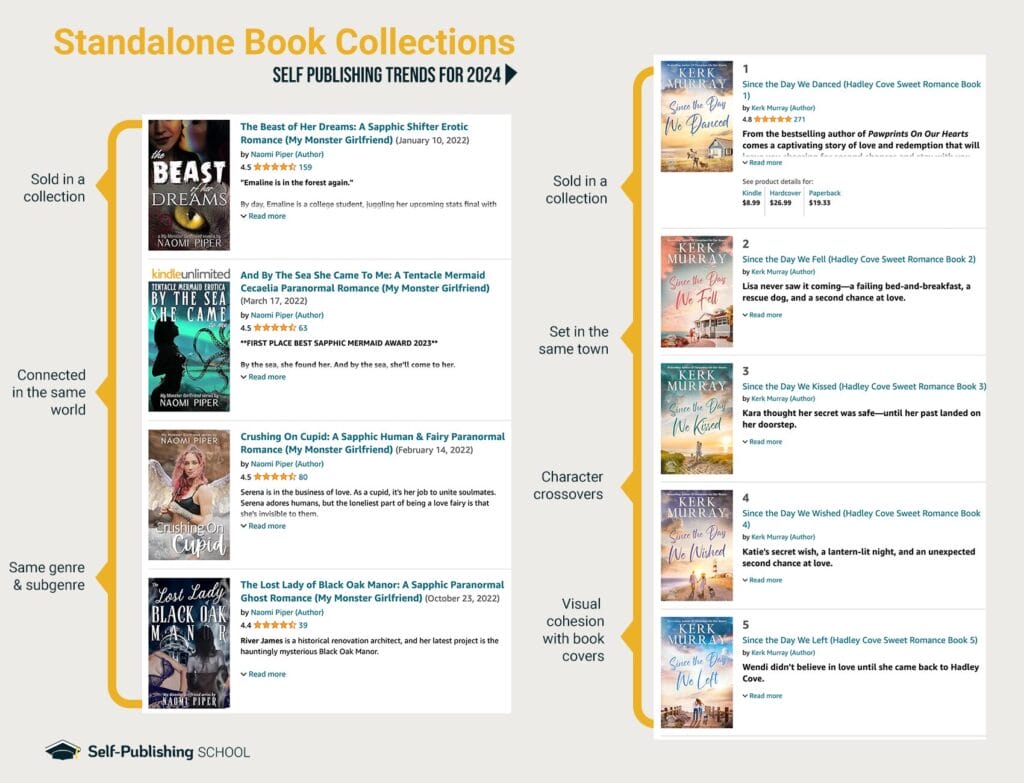
Note: Of course, genres like mystery or spy thrillers have used this strategy in some ways. The way this self publishing trends for 2024 is different is that these books don’t often maintain the same protagonist the way those genres do.
3. Book Catalog Strategy
In the self-publishing world, strategy is becoming evident in many successful authors. Authors are no longer only writing what they want. They’re formulating a long-term plan with books that go together or are connected in ways that make for significant marketing.
This does include the above trend, but this is one of the self publishing trends for 2024 that has more to do with the business of writing and authorhood versus taking a consumer-lens of the trends. It’s playing the long game by putting together a book catalog strategy to withstand future trends.
Because trends don’t often come and go in a single year. They usually slowly pick up speed, peak, and fall off. Or they continue to rise and just plateau, sticking around for years to come. By creating a book strategy now that includes some of these self publishing trends for 2024, and then building them out over the next few years, you’ll have a blueprint for having a thriving author income by 2027.
This is very similar to the way nonfiction authors are going about it for their stair-step multiple book strategy. Except in their case, they’re developing more of a beginner, intermediate, advanced approach. For you, this is more like you’re pulling the reader into your world and showing them various elements from your genre that are typically popular.
For fiction authors, this looks like:
- Choosing a highly specific genre and subgenre
- Creating a plan for writing a few standalones that can be sold in a box set
- Creating a plan for a sequential book series
- Researching and uncovering what readers love and don’t love about that genre
- Executing on your plans
This sounds like a lot of preparation, and sometimes it is. Especially if you want to write to trend and capitalize on predictable reader behavior. But if this is too much for you right now, that’s okay.
Just start with that specific genre and subgenre.
4. “Human-Made” and “Non-AI” Labeling
The debate over AI creating art is still a rough one. Some believe it’s the best thing to hit the book world to help authors in years. Others think it’s single handedly devaluing creatives of all kinds. No matter where you stand on the AI in fiction issue, any divide will create a method for others to know which side they’re on.
Or just the classification of a book not being made by AI is becoming increasingly important, particularly as Amazon utilized AI narration for audiobooks.
Some readers are boycotting out of principle. Some people don’t yet care.
While we may not see the true effects of this for some time, it’s not out of the world of possibility for authors and even Amazon itself creating a way to showcase whether or not a book has been created using AI.
Amazon has followed consumers in many ways before, and if this issue prevents books from being sold (and therefore Amazon from making money), they will respond appropriately. But it might not be Amazon that makes the change, and authors may take charge themselves.
This would be similar to one of the self publishing trends from years prior, in which authors began placing “trigger warnings” within the book description itself.
Possible locations for such a feature would be either in the “Product Details” or as a symbol just beneath the book description that houses page number, language, publication date, and more.
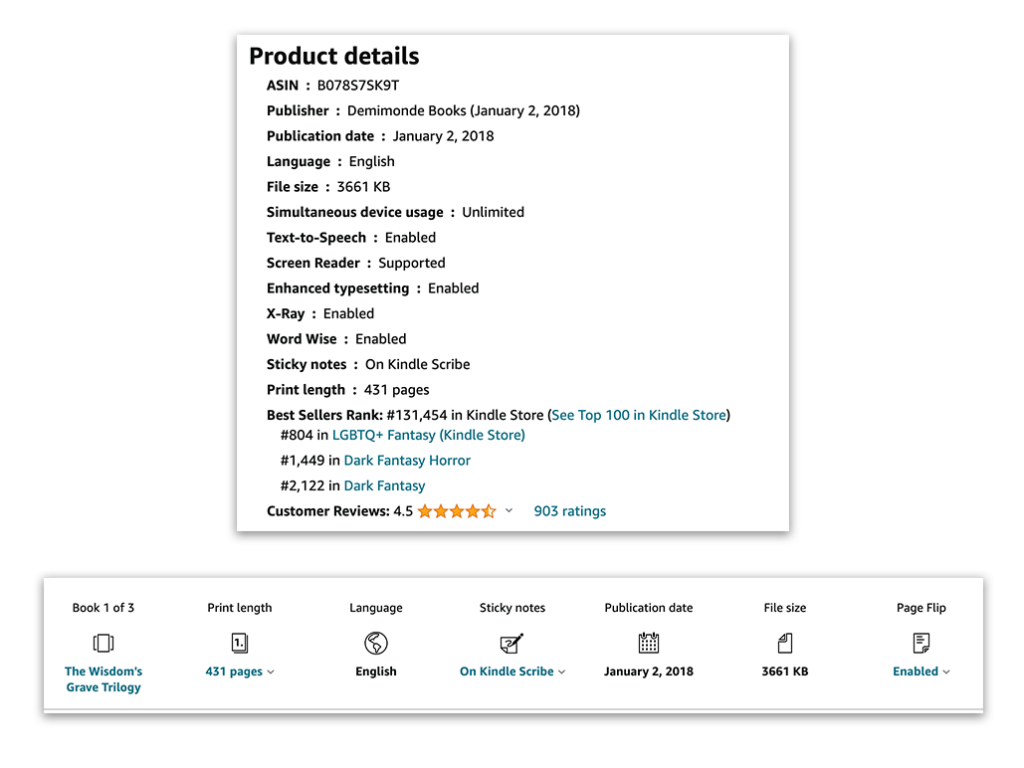
And in fact, Apple books is already displaying such information.
Keep this in mind, even for updating your book’s description on Amazon. You can make the case yourself first, instead of waiting for Amazon. That will allow readers to know your book doesn’t (or does) use AI so they can shop within their values.
5. Special Edition Runs
The best fans for an author to gain are the die-hards. The raving fans. The ones who want every version of a book there is, especially if it’s pretty. There are even blogs dedicated to showcasing upcoming special editions of books. Now, unless you already have a large audience, that’s hard to do. But thankfully, there’s a way you can create this sort of fan-crazed frenzie, and that’s with special edition runs of your book.
This is one of the self publishing trends for 2024 that may require some investments, but could pay off majorly when it comes to getting new fans.
Some readers will indeed judge a book by its cover, because they care about how nice it looks on their shelves. Yes, they will probably read it at some point, but they will buy a pretty book simply because it’s gorgeous. The great thing about this is that many will also post about it because it looks cool.
You’ll end up selling copies and having them marketed just from the special edition.
In fact, there’s speculation that the first book in a series Fourth Wing went viral in reader groups (and therefore the book community as a whole) because of a specific edition of the book in which the page edges are colored black. This prompted many to share the book in groups, which created the virality and buys.
Of course, a pretty book on its own won’t garner this attention so while this is one of the stronger self publishing trends for 2024, it does still require a well written book.

How you can customize the special editions:
- Illustrations inside the book
- A new cover
- Covers that line up and create a design when on the shelf
- Detail to the page lining
- Special hardcover details (beneath the sleeve, even)
You can’t just throw out a special edition for a single book, though. Not unless it gains massive popularity. Instead, there are certain times it works best, and almost always is better with a full series or collection, and not if you only have 3 books and plan to write 5.
The best times to create special editions:
- When a series or collection is newly completed
- Before major holidays
- As a milestone for reaching a certain audience size
- With a giveaway or event of some kind
6. Collaborative books / worlds
Being an author used to be lonely. A writer wouldn’t have many friends who wrote, and so they’d be creating their projects on their own. But the internet has connected us in many ways. Now, there are groups and groups of writers all looking to connect and get feedback from one another.
From there, some go on to write by themselves, but others find that they enjoy working as a group on a project more than going it alone. This is happening more and more, and it’s creating an interesting dynamic.
There are even more writers seeking advice about this topic in online forums like Reddit:

An example of a collaborative book and world is Unfound Adventures and their Tales of Bastunia comic series. They’re a team of 3 both plotting, writing, and creating the stories in the world together. They identified that, while they all loved the idea, each had certain strengths:
Dillon with his vision and ability to manage the lore.
Matthew with his prose and ability to write fiction.
Evan with his imaginative translation of the written medium to the visual.
Together, they’ve created a comprehensive world, comics, short stories, and upcoming novels that none could have created on their own.
You don’t have to start new, either. Many authors collaborate with other authors in their genre in order to publish together and share audiences, which helps each other grow book sales in other ways, too.
BONUS: One to Watch—Reader-Led Books
For Fiction:
Fans want a say in the story. Many get so upset with the author’s choices they even take to the interwebs to write fanfiction of how they wish it would go. As communities become more intimate, with the gap between author and reader being smaller than ever, there is an opening for authors to poll their readers to help them write a book.
This isn’t yet out there, and is definitely a trend to keep an eye out for should you actually see it.
For Nonfiction:
This can happen similarly for nonfiction authors, too. It would look like serving their existing audience by getting direct feedback on ideas and desires that inform what the book is about, in addition to having their audience supply them with stories and statistics to put in the book. This helps maximize giving people what they need and increases the chances of the audience buying, both because it fulfills their needs but also because they were a part in creating it.
Self-Publishing Microtrends to Watch for in 2024
Microtrends in this context is used to describe very clear potential in smaller segments of the writing world. This might look like genre or subgenre-specific trends or trope trends. You might also find culturally influential self publishing trends for 2024 in this list based on movies, TV shows, or other popularized phenomenon, which undoubtably play a role in entertainment consumption desires (what books people are in the mood to read).
It doesn’t take much to showcase the impact of the first season of Bridgerton on books sales of regency romances.
Fiction:
- Bridgerton / Regency / Romance: A new season of Bridgerton will come out on Netflix in the spring of 2024, and as with the previous two seasons, it will lead to an increase in books of that type being read.
- Genre mashups: The success and rise of the “romantasy” genre is already encouraging authors to think outside the box and try to find that same crossover appeal in other genres. Perhaps it will look like Mystery and Fantasy? Or even science fiction comedy. Keep an eye out for opportunities to fulfill multiple genres in one story while still maintaining genre expectations.
- Professional sports / entertainer romances: Taylor Swift and Travis Kelce are everywhere, and because of that, there are plenty of people in reader groups already asking for books that might give readers an inside peek into a romance like theirs.
Nonfiction:
- Homesteading: The pandemic awoke people to a simpler life, one in which they make their own food at home (due to the restaurants being closed during that time). We’re still seeing the rise and it will continue to add to the self publishing trends for 2024.
- Self-sufficiency: More people want to rely less on money, the government, and others. There’s been an increase in self-sufficiency social media pages that will undoubtably translate to books.
- Politics: 2024 is an election years, which makes it a no-brainer that books of this nature will trend. What’s popular in culture translates to entertainment.
With any of these self publishing trends for 2024, you don’t want to try to do them all. Find a couple that are already in line with what you want to do, and get to work! Put your plan together, and publish.
